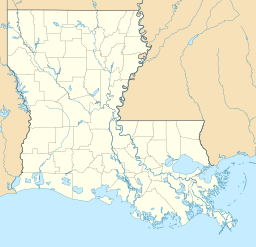Lake Peigneur facts for kids
Quick facts for kids Lake Peigneur |
|
|---|---|
| Location | Iberia Parish, Louisiana |
| Coordinates | 29°58′52″N 91°58′59″W / 29.981°N 91.983°W |
| Primary inflows | estimated 8.47 cu ft/s (0.240 m3/s) from catchment |
| Primary outflows | Delcambre Canal |
| Catchment area | 10.2 sq mi (26 km2) of the Vermilion-Teche Basin |
| Basin countries | United States |
| Surface area | 1,125 acres (455 ha) |
| Average depth | 3 ft (1 m) |
| Max. depth | 200 ft (61 m) |
Lake Peigneur is a special lake in Louisiana, United States. It has slightly salty water, which is called brackish water. The lake is about 1.2 miles (1.9 km) north of Delcambre. It is also about 9.1 miles (14.6 km) west of New Iberia. Lake Peigneur is the deepest lake in Louisiana, reaching a depth of 200 feet (61 meters).
Before 1980, Lake Peigneur was a shallow freshwater lake. It was only about 10 feet (3 meters) deep. It was a popular spot for fishing and other water sports. But on November 20, 1980, something very unusual happened. A man-made disaster completely changed the lake and the land around it.
Contents
The Drilling Disaster of 1980
On Thursday, November 20, 1980, a big accident happened at Lake Peigneur. The Diamond Crystal Salt Company had a salt mine deep under the lake. At the same time, a company called Texaco was drilling for oil above the mine. They were using an oil rig to explore for oil.
What Caused the Disaster?
The exact cause of the disaster is not fully known. This is because much of the evidence was washed away. However, it is believed that the drill from Texaco's rig hit the roof of the salt mine. This happened just a few hours before the lake started to drain. Engineers from Texaco and Diamond Crystal later worked together. They thought the drill might have pierced the mine's 1300-foot level. If this is true, Texaco made a big mistake about where their drill was compared to the mine.
How the Lake Disappeared
When a hole opened in the lake's bottom, the water began to pour into the mine. The rushing water washed away soil and salt. This made the hole bigger and bigger. The water filled the huge empty spaces in the mine. These spaces were left from salt that had been removed since 1919.
The lake quickly drained away. This created a giant sinkhole. The sinkhole swallowed many things. It took the drilling platform, eleven barges, a tugboat, and many trees. It also swallowed about 65 acres (26 hectares) of the surrounding land.
A Giant Waterfall and Geysers
So much water drained into the mine that the nearby Delcambre Canal changed direction. This canal usually empties the lake into Vermilion Bay. But now, salty water from the Gulf of Mexico flowed backwards into the dry lakebed. This created a huge waterfall. For a few days, it was the tallest waterfall ever in Louisiana, at 164 feet (50 meters) high! The lake then refilled with this salty water.
As water rushed into the mine, it pushed out the air inside. This air shot out of the mine shafts like giant air cannons. Later, water shot out as 400-foot (122-meter) geysers.
Everyone Escaped Safely
Amazingly, no people lost their lives in this disaster. All 55 employees who were in the mine escaped safely. Six of them even received awards for being brave. The 7 crew members on the drilling rig also got off the platform just before it collapsed. A fisherman on the lake quickly steered his small boat to shore and escaped.
Days after the event, the water pressure inside the mine became equal. Then, nine of the eleven sunken barges popped back up to the surface of the lake! Only three dogs were reported to have died.
After the Disaster
After the disaster, Texaco and the drilling company, Wilson Brothers, paid a lot of money. They paid $32 million to Diamond Crystal Salt Company. They also paid $12.8 million to a nearby garden called Live Oak Gardens. This money was to help pay for the damage caused by the accident.
Investigation and Mine Closure
In August 1981, a report was released about the disaster. It explained everything that happened. However, it did not officially say what caused the accident. The salt mine was finally closed in December 1986.
Lake Peigneur Today
Since 1994, a company called AGL Resources has used the salt dome under Lake Peigneur. They use it to store natural gas under high pressure. Some local residents have worried about the safety of storing gas there. They are also concerned about new drilling operations nearby.
Why the Lake is Salty Now
After the disaster, Lake Peigneur became salty. This was not because salt from the mine dissolved into the water. Instead, it was because salty water from the Delcambre Canal and Vermilion Bay flowed into the lake. These waters are naturally salty or brackish. The disaster permanently changed the lake's environment. It turned the lake from a freshwater lake into a saltwater lake. It also made part of the lake much deeper.




